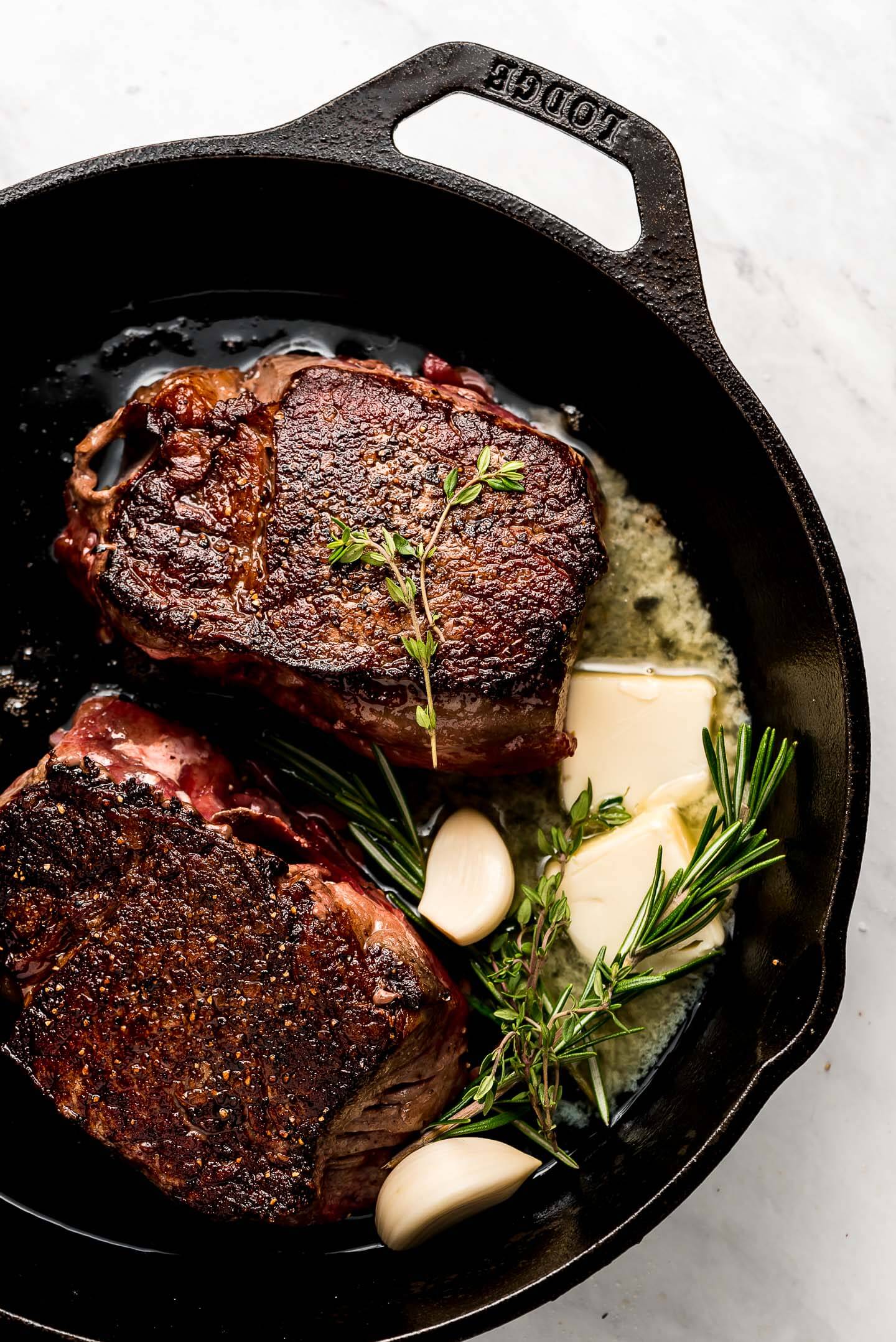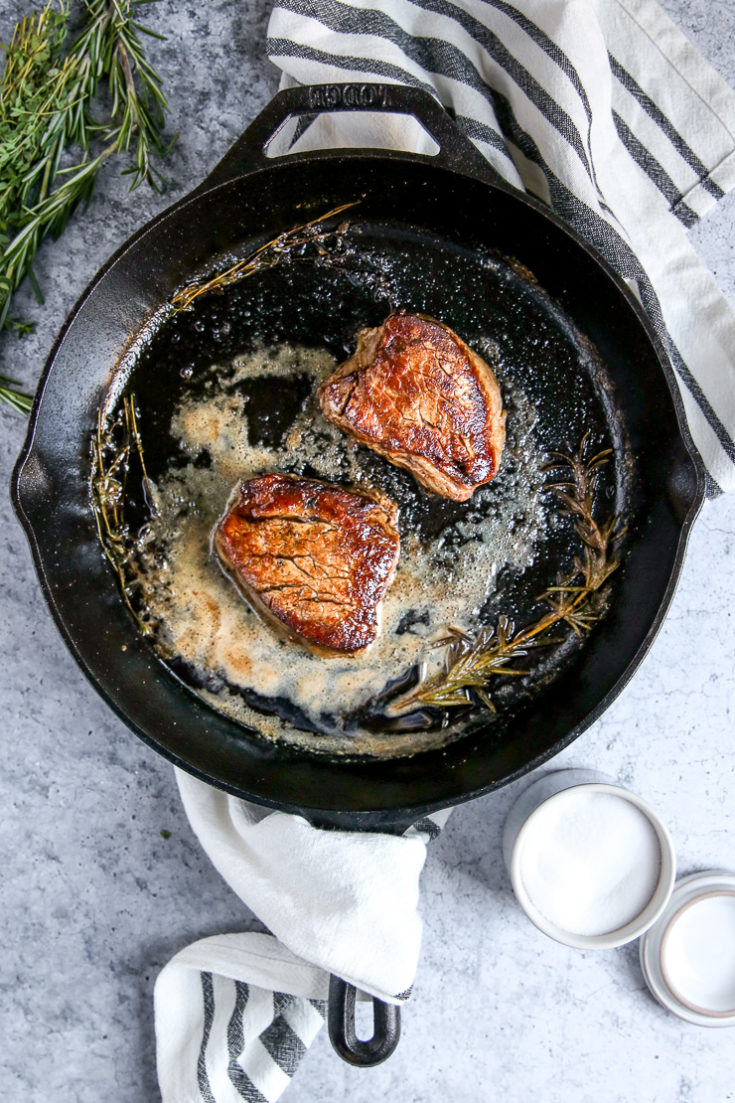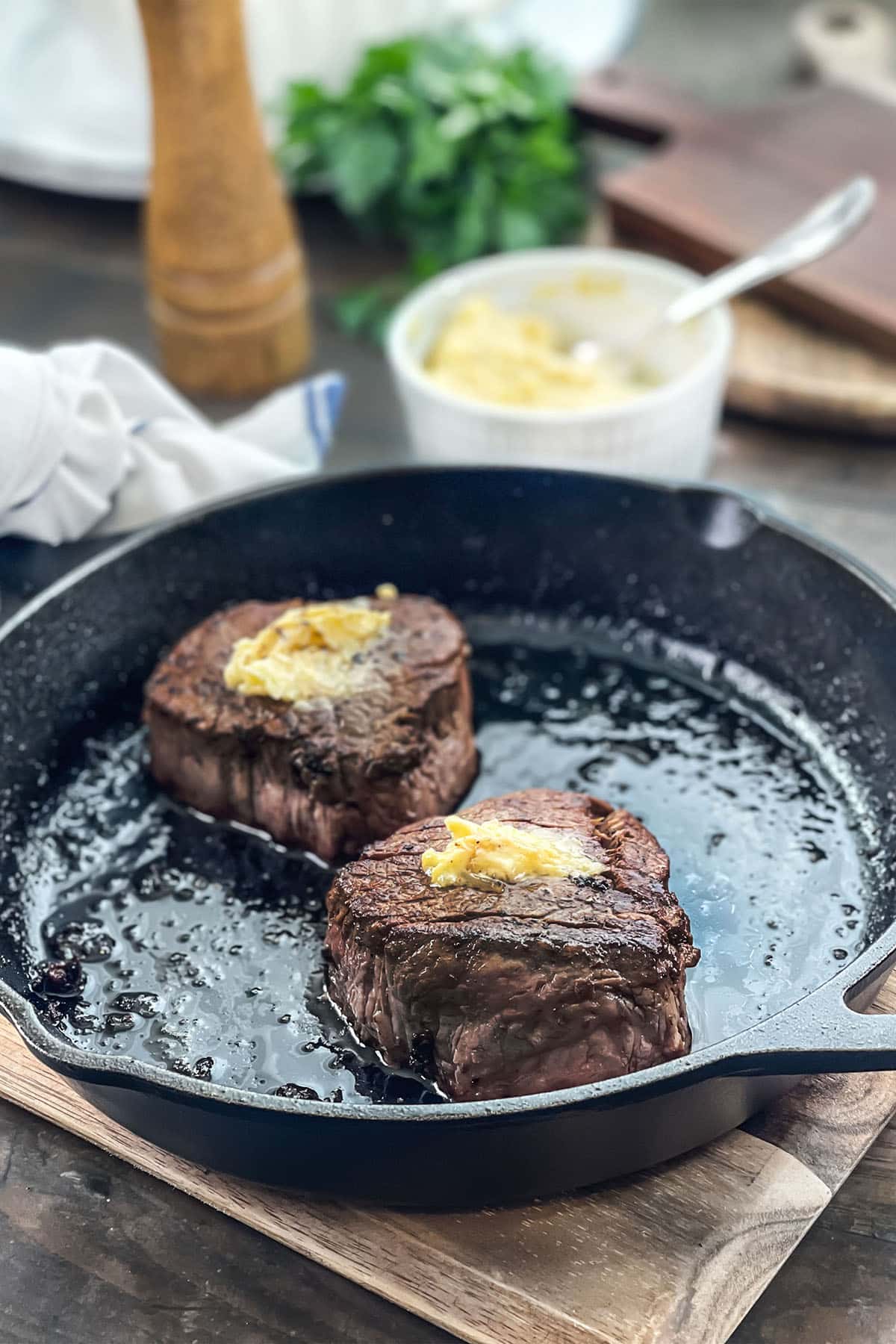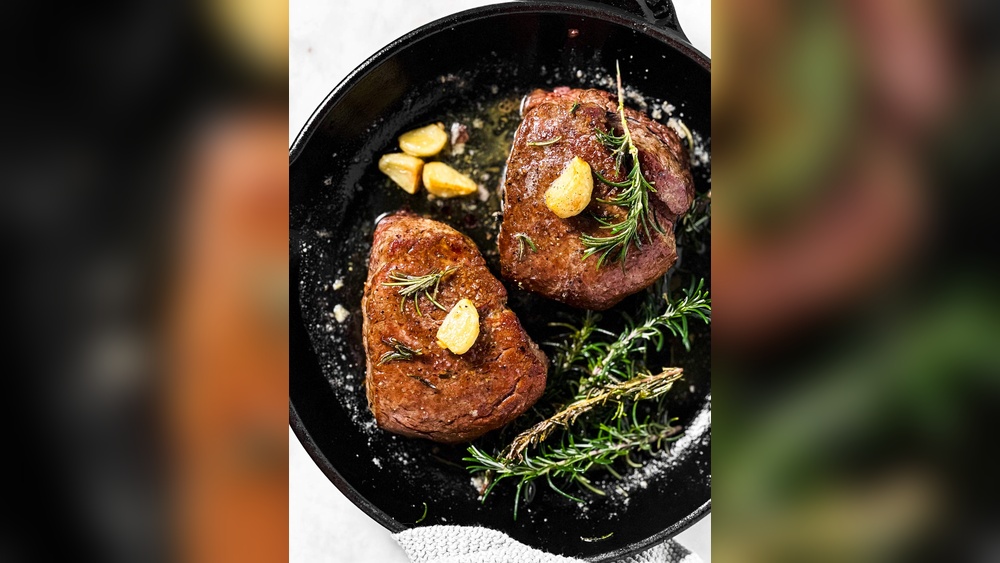If you want to cook a tenderloin steak that’s juicy, flavorful, and perfectly seared, using a cast iron skillet is your best bet. You might think it’s tricky to get restaurant-quality results at home, but with the right steps, you can impress yourself—and anyone you’re cooking for.
This guide will show you exactly how to turn a simple steak into a mouthwatering meal. Ready to master your cast iron and enjoy steak like never before? Keep reading and discover the secrets to cooking the perfect tenderloin steak.

Credit: www.garnishandglaze.com
Choosing The Right Tenderloin Steak
Choosing the right tenderloin steak is key for a delicious meal. This cut is known for its tenderness and mild flavor. Picking the best piece makes cooking easier and the steak tastier. Quality and size matter most in this choice.
Selecting Quality Meat
Look for bright red color and firm texture. Avoid meat that looks brown or feels slimy. Good marbling, the thin white fat lines, adds flavor. Freshness is important. Check the sell-by date and smell the meat. It should smell clean, not sour.
Thickness And Cut Considerations
Choose steaks about 1.5 to 2 inches thick. Thicker steaks cook more evenly and stay juicy. Thin steaks cook too fast and can dry out. Pick whole tenderloin or center-cut steaks for best results. The center cut is more uniform and easy to cook.

Credit: www.theculinarycompass.com
Preparing The Steak
Preparing a tenderloin steak properly sets the foundation for a delicious meal. This step ensures even cooking and rich flavor. Two key parts of preparation are bringing the steak to room temperature and seasoning it well.
These simple actions improve the texture and taste of the steak. Follow these tips to get ready before cooking your tenderloin in a cast iron skillet.
Bringing Steak To Room Temperature
Take the steak out of the fridge about 30 to 60 minutes before cooking. Cold meat cooks unevenly and can stay raw inside. Room temperature steak cooks faster and more evenly.
Place the steak on a plate. Leave it uncovered or lightly covered. This small wait helps the steak reach a better temperature for cooking.
Seasoning Techniques
Seasoning adds flavor and forms a tasty crust on the steak. Use salt and pepper as basic seasonings. Sprinkle them evenly on both sides of the steak.
Pat the seasoning gently into the meat. Avoid rubbing too hard to keep the texture intact. For extra flavor, add garlic powder or dried herbs.
Let the seasoning sit on the steak for a few minutes. This allows the salt to draw moisture and enhance taste. Proper seasoning makes your tenderloin steak more delicious.
Prepping The Cast Iron Skillet
Prepping the cast iron skillet is a key step for cooking tenderloin steak. A well-prepared skillet ensures even cooking and a perfect sear. It also helps prevent the steak from sticking. Follow simple steps to get your skillet ready.
Cleaning And Oiling
Start by cleaning the skillet with hot water. Avoid using soap, which can remove the seasoning. Use a brush or a scrub pad for tough spots. Dry the skillet completely to stop rust.
Next, apply a thin layer of oil. Use oils with a high smoke point, like vegetable or canola oil. Spread the oil evenly on the skillet surface with a cloth or paper towel. This keeps the skillet smooth and non-stick.
Heating To Optimal Temperature
Place the skillet on the stove over medium-high heat. Let it heat up for 5 minutes or until it is very hot. A hot skillet creates a nice crust on the steak.
Test the heat by sprinkling a few drops of water. They should sizzle and evaporate quickly. Avoid overheating, which can burn the oil and damage the skillet.
Searing The Steak
Searing a tenderloin steak in a cast iron skillet is a crucial step. It locks in juices and builds flavor. This step gives the steak a rich, brown crust that tastes great. The heat from the skillet caramelizes the meat’s surface. This process is called the Maillard reaction. It creates a delicious, savory taste and texture.
Achieving A Perfect Crust
Start by heating the cast iron skillet until it is very hot. Use a high smoke point oil like canola or vegetable oil. Pat the steak dry to remove moisture. Moisture stops the crust from forming well. Place the steak gently in the skillet. Do not move it for a few minutes. This helps the crust form evenly. Flip the steak once the crust is deep brown. Avoid pressing the steak down. This squeezes out juices and dries the meat.
Timing And Temperature Control
Keep the skillet hot but not smoking. Too much heat can burn the crust. Too little heat will not sear properly. Sear each side of the steak for about 2-3 minutes. Adjust the time based on steak thickness. Thicker steaks need more searing time. Use a timer to track cooking. This prevents overcooking or undercooking. After searing, lower the heat to finish cooking inside.
Finishing In The Oven
Finishing a tenderloin steak in the oven after searing it in a cast iron skillet helps cook the steak evenly. The hot skillet locks in flavor and creates a nice crust. The oven then gently cooks the steak to the perfect doneness without burning the outside.
This method works well for thick steaks. It prevents overcooking the edges while the inside stays raw. Using the oven also gives you more control over the final temperature of the steak.
When And How To Transfer
Start by searing the steak on high heat for 2-3 minutes on each side. The steak should have a brown crust before moving it to the oven. Use oven mitts to safely transfer the hot skillet to the preheated oven.
Place the skillet on the middle rack for even heat. The oven temperature should be around 400°F (204°C). Cook the steak in the oven for 5-10 minutes depending on thickness and desired doneness.
Using A Meat Thermometer
A meat thermometer ensures the steak reaches the right temperature. Insert it into the thickest part of the steak. Avoid touching the bone or skillet.
For medium-rare, aim for 130-135°F (54-57°C). Medium is 140-145°F (60-63°C). Remove the steak from the oven a few degrees before the target. The temperature rises slightly while resting.
Rest the steak for 5 minutes before slicing. This keeps the juices inside and makes the steak tender.
Resting And Serving
After cooking your tenderloin steak in a cast iron skillet, resting and serving are key steps. Resting lets the juices settle inside the meat. Serving it right makes the steak look and taste better. Follow simple tips for the best results.
Importance Of Resting
Resting keeps the steak juicy and tender. Cutting the steak right away makes the juices run out. Wait at least 5 minutes before slicing. Cover the steak loosely with foil. This keeps it warm without steaming.
Cutting And Presentation Tips
Cut steak against the grain for easy chewing. Slice it into thin, even pieces. Arrange the slices neatly on a warm plate. Garnish with fresh herbs or a small pat of butter. Presenting well makes your meal more inviting.
Common Mistakes To Avoid
Cooking tenderloin steak in a cast iron skillet can be easy and rewarding. Avoiding common mistakes helps keep the steak juicy and flavorful. Many cooks make simple errors that change the taste and texture.
Here are two key mistakes to watch out for during cooking. Fixing these can improve your steak every time.
Overcooking
Overcooking is a frequent problem with tenderloin steak. This cut cooks fast because it is thin and tender. Leaving it on the heat too long makes it dry and tough.
Use a timer or a meat thermometer. Aim for medium-rare or medium for the best taste. Remove the steak from the skillet as soon as it reaches the right temperature.
Skipping The Resting Period
Skipping resting after cooking is a big mistake. Resting lets juices spread inside the steak. Cutting the steak right away causes juice to run out.
Let the steak rest for about 5 minutes. Cover it loosely with foil to keep heat. This step keeps the meat moist and tasty.
Enhancing Flavor
Enhancing the flavor of tenderloin steak in a cast iron skillet makes every bite delicious. Simple ingredients and careful techniques bring out the rich taste. Small touches create a big difference in flavor.
Using Butter And Herbs
Butter adds a smooth, rich taste to the steak. It melts in the hot skillet, coating the meat perfectly. Fresh herbs like thyme, rosemary, or sage give a fragrant aroma. They infuse the butter, then the steak, with natural flavors. Basting the steak with butter and herbs keeps it moist. This method builds layers of taste and tenderness.
Adding Aromatics
Aromatics like garlic and shallots boost the steak’s flavor deeply. Crushing garlic releases its pungent, savory oils. Shallots add a mild, sweet onion flavor. Toss these in the skillet with the steak. They cook quickly and share their aroma with the meat. Aromatics create a flavorful environment that enhances each bite.

Credit: cookthestory.com
Frequently Asked Questions
How Do You Prepare Tenderloin Steak For Cast Iron Cooking?
Trim excess fat and pat the steak dry with paper towels. Season generously with salt and pepper for best flavor. Let it sit at room temperature for 30 minutes before cooking to ensure even heat distribution.
What Is The Ideal Cooking Time For Tenderloin Steak?
Cook tenderloin steak for 3-4 minutes per side on medium-high heat. Adjust time based on thickness and desired doneness. Use a meat thermometer to check internal temperature for perfect results.
Should I Use Oil Or Butter In The Cast Iron Skillet?
Start with a high smoke point oil like canola or avocado oil. Add butter during the last minute for rich flavor and browning. This combination helps create a delicious crust on the steak.
How Do I Know When The Steak Is Perfectly Cooked?
Use a meat thermometer: 125°F for rare, 135°F for medium-rare, and 145°F for medium. Let the steak rest 5 minutes after cooking to allow juices to redistribute evenly.
Conclusion
Cooking tenderloin steak in a cast iron skillet brings great results. The skillet holds heat well and cooks steak evenly. A hot pan helps create a nice crust. Remember to rest the steak before serving. This keeps the meat juicy and soft.
Simple steps make a tasty, tender steak every time. Try this method for your next meal. Enjoy the rich flavor and perfect texture. Cooking steak at home can be easy and fun. Cast iron skillets are a great tool for steak lovers.

